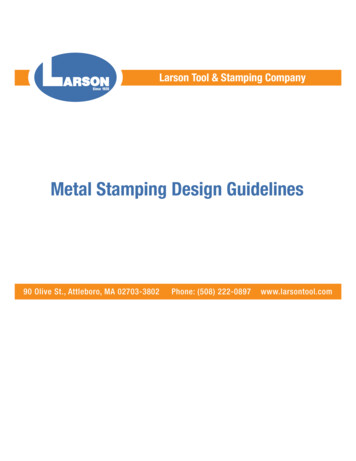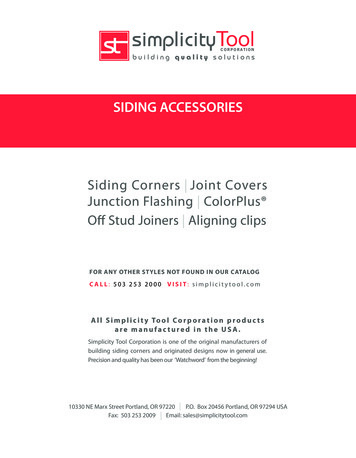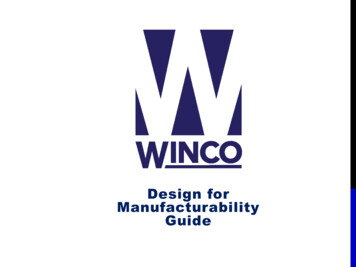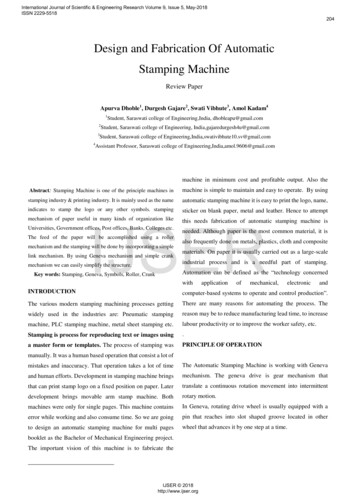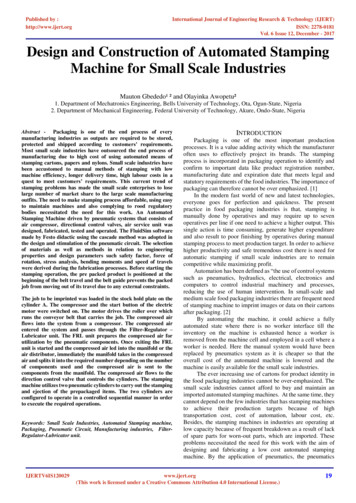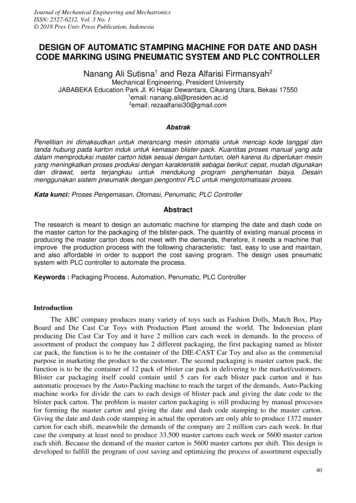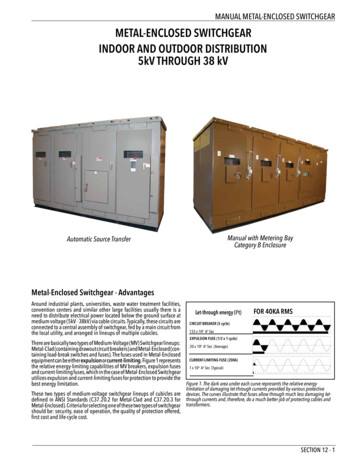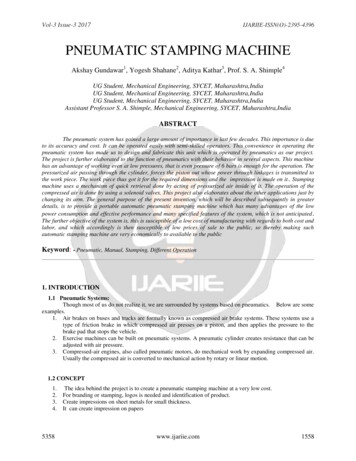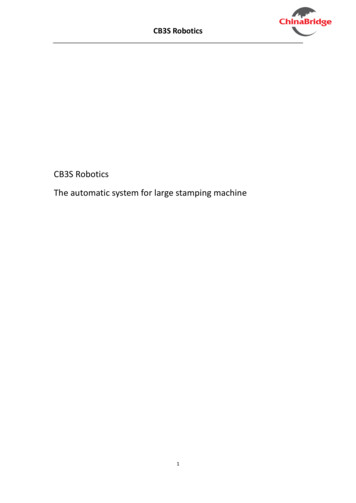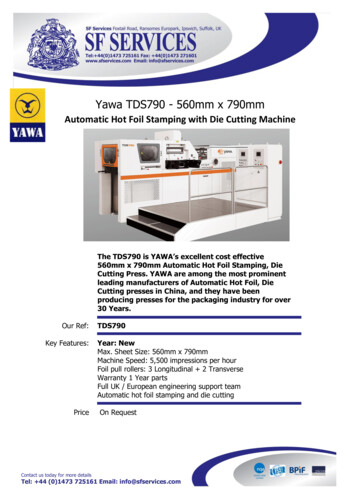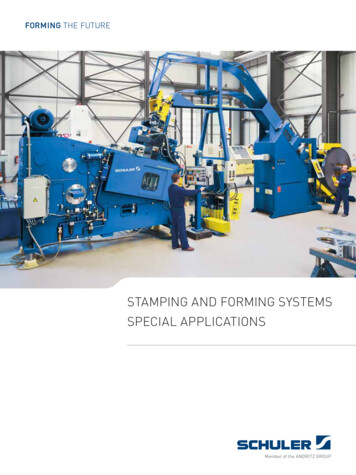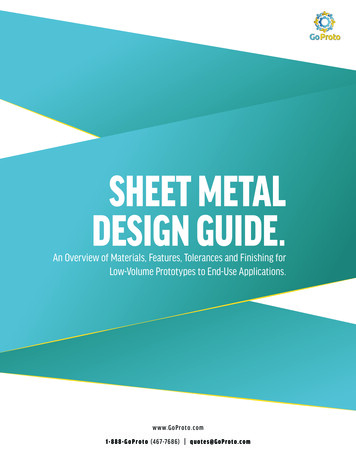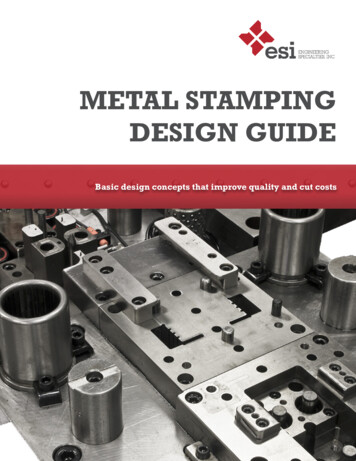
Transcription
METAL STAMPINGDESIGN GUIDEBasic design concepts that improve quality and cut costs
IntroductionMetal stamping is a complex process that can include a number of metal forming processes —blanking, punching, bending, and piercing, to name a few.All of these processes come with fundamentals that, when followed, allow manufacturers toproduce the highest quality components for the lowest costs. It’s also critical to understand thesefundamentals so you can: Avoid costly errors Know what to expect in terms of costs and lead times Receive the highest quality components so your application performs at its bestThe following guide illustrates best practices and formulas commonly employed in the metalstamping design process and includes tips to incorporate cost cutting considerations into your part.452 Twin Lakes Rd North Branford, CT 06471www.esict.com Phone: 800-486-5546 Fax: 800-486-28252
BlankingBlanking — cutting the rough, basic shape — is often the first step for a stamped metal part. Theprimary concerns at the blanking stage of the design are minimizing and avoiding burrs, whichrequire secondary processing to remove and can drive up the cost of your part and extend lead time.PiercingPiercing is a common metal stamping process and ideal for forming holes and slots fully enclosedwithin the edges of a part. There are a number of factors to consider when designing stamped metalparts with holes to ensure proper manufacturing and functionality.Hole DiameterThe minimum diameter of any hole should be 1.2x the material thicknessor larger. Holes in materials with high tensile strength, such as stainlesssteel alloys, should be at least 2x wider than the material is thick.MIN. Ø 1.2THoles with smaller diameters require specialized punching or drillingprocesses, which themselves often require deburring. Specializedprocesses add to the cost of your part.Hole Geometry/TaperWhen a hole is punched in the stamping process it does not have a constant profile through the entirethickness of the part. The section view of a punched hole is shown below. The taper in the bottomside of the hole is caused by the punched hole diameter breaking through the material. The amountof taper in a punched hole is relative to the die clearance between the punch and the die used topunch the hole geometry.PUNCHED HOLEMACHINED HOLEIf a constant diameter is needed through the entire material thickness, a part must be drilled ormachined as a secondary operation, resulting in much higher piece price.452 Twin Lakes Rd North Branford, CT 06471www.esict.com Phone: 800-486-5546 Fax: 800-486-28253
Edge-to-Hole SpacingThe web — the space between a hole and the edge of a part — should beat least twice the distance as the material is thick. If edge-to-hole spacingis less than this distance, bulging along the edge will occur. If holes arerequired nearer to the edge than twice the material thickness, and bulgemust be avoided, specialty drilling processes will be required.WEBFor oblong slots that are less than 10 material thicknesses long, edge-tohole spacing should be 2x material thickness; oblong slots longer than10 material thicknesses require edge-to-hole spacing of at least 4x thematerial thickness to avoid bulging.BULGEBendingMetal stamping is a linear process wherein one step is performed after another, after another, and so onuntil a completed part is produced. The best stamped metal part designs take this step-by-step nature of thestamping process into consideration.One of the more substantial forms, often performed toward the end of the progressive die stamping process,is bending. When designing bends into your stamped metal part, it is important to allow for enough material— make sure to design your part and its blank so that there is enough material to perform the bend.Forming Bends Near HolesWhen a bend is made too close to a hole, the hole becomes deformed.For holes or slots less than 2.5mm in diameteror width, the minimum distance between ahole and the bend should be 2x the materialthickness, plus the radius of the form.For holes greater than 2.5mm in diameter, theminimum distance should be 2.5x the materialthickness plus the radius of the form.2T RRDD 2T452 Twin Lakes Rd North Branford, CT 06471www.esict.com Phone: 800-486-5546 Fax: 800-486-28252.5T RRDD 2.5T4
Allowing less space than these standards will result in the hole distorting, bulging or stretchingoutside of its tolerances. Holes that must be closer to a form may require a post-stamping drillingprocesses, which can be very expensive.Notches and TabsNotches and tabs, as well as slots, should be designed with widthsthat are at least 1.5x the thickness of the material. If made anysmaller, they can be difficult to create due to the force exerted onpunches, causing them to break. In certain design situations, highprecision stampers can accommodate smaller measurements, butbe sure that they are absolutely necessary.NOTCHWTABMIN. W 1.5TTMIN. RADIUSR .5TCornersREvery corner in your blank design should have a radius that is atleast half of the material thickness. If your material is 1.5mm orless in thickness, corners can be very sharp.RRTRRBurrsBurr allowance is generally 10% of the thickness of the sheet material. To minimize instances andseverity of burrs, avoid sharp corners and complex cutouts when possible. When such factors cannotbe avoided, be sure to note burr direction in your design so they can be taken into account duringstamping (See the “Stamped Edges” image below). Vibratory and tumble finishing can be performed toremove burrs when unavoidable.Stamped EdgesWhen metal is cut or sheared, the applied downward stress on the material causes it to fracture assoon as the metal’s shear strength — the maximum strength a material withstands before separatingat the cut location — is met. This action creates a burr on the bottom edge of the material, as shownin the diagram.This “stamping burr” from the cutting process is critical forproduct designers to understand, as it creates an angle whichcan cause dimensional measurements to differ as comparedto measuring from the burnished area. While this differenceis very slight, it can come into play when parts are being heldto very tight tolerances. The height of the burr, the fractureangle, and the depth of the fracture can vary depending onmaterial type, punch to die clearance and tool sharpness.452 Twin Lakes Rd North Branford, CT 06471www.esict.com Phone: 800-486-5546 Fax: 800-486-2825Penetration depthPENETRATIONDEPTHROLLOVERDEPTHRollover depthBurnish depthBURNISHDEPTHFRACTUREDEPTHFracture depthBurr heightBURRDEPTHFractureFRACTUREangleANGLE5
CoiningCoining the edges of a part is sometimes an option when trying to avoid costly secondary processeslike vibratory deburring or edge grinding. During the coining process, edges of a stamped metal partare struck in such a manner as to flatten or break the burr; this can create a much smoother edge inthe coined area of the part geometry. In addition to providing cost savings from secondary processes,coining can also add additional strength to localized areas of the part.Plasticity and Grain DirectionPlasticity is the measure of permanent deformation a material undergoes when subjected to force.The more plasticity a metal has, the easier it is to form. High plasticitymetals such as aluminum, brass, copper, and mild varieties of steelare formed easily and may require fewer considerations in regards tobends. The grain direction of these metals is not a major concern, andthey generally require an inside bend height minimum of 20% less thanhigher strength metals (See bend height section below).GRAIN DIRECTIONCRACKGRAIN DIRECTIONWhen bending high strength materials — tempered metals, stainlesssteels, and so on — grain direction becomes very important. Bends that goalong the grain of a high strength metal are prone to cracking, which willmake your part susceptible to failure. Thus, it becomes important to designbends in high strength material parts against the grain of the material.NO CRACKBend HeightWhen adding a bend or form to a stamped metal part, the height of thebend becomes a design consideration. The thickness of the materialcomes into play when considering the overall height of the bend from thebase material. The overall height of a bend has minimum requirementsto be formed effectively and should be at minimum, 2.5x the thicknessof the material the radius of the bend. At times, the height of a bendmay be less than 2.5T R but can require costly secondary operations.TRH 2.5T RBend ReliefWhen a bend is made too close to an edge, the material on the base of the part along either side ofthe bent section may tear, drastically reducing the integrity of your part. Whenever possible, portionsalong an edge that are meant to be bent should be designed with an offset of extra material, at leastas much as the radius of the bend.BEND OFFSETBEND TEAR452 Twin Lakes Rd North Branford, CT 06471www.esict.com Phone: 800-486-5546 Fax: 800-486-2825BEND RELIEF6
When an offset cannot be included into a design, consider including bend relief notches in its stead.Bend relief notches are small notches located immediately adjacent to the portion of the part to bebent — they should be a minimum of twice as wide as the material is thick, and as long as the bendradius plus material thickness.Bend Distortion/BulgeAn exaggerated example of bend distortion/bulge is pictured below. The bulging caused by thisdistortion can be as large as ½ the material thickness. As material thickness increases and bendradius decreases the distortion/bulge becomes more severe. If bending distortion or bending bulgeis unacceptable, the part can be relieved prior to bending with a relief notch on either side of thebend (See image below).PART PRIOR TO BENDINGBEND LINEBEND RELIEF NOTCHBEND DISTORTIONCountersinksCountersinks are a common form utilized in stamped metal parts where the application calls fora variety of fasteners including flathead screws. There are several ways a countersink may beformed depending on the application or the quality necessary for the countersunk hole. Onemust keep in mind that in any countersinking operation a very small amount of material may riseabove the surface of the material and create a very small “bulge” around the diameter of the hole(See image below).BULGE FROMCOUNTERSINKDETAIL100:1COUNTERSUNK HOLE452 Twin Lakes Rd North Branford, CT 06471www.esict.com Phone: 800-486-5546 Fax: 800-486-28257
Carrying Web and “Mismatch” CutDuring the design stage of a new progressive die, a conversation that should always happen withthe customer is where the part will be carried in the strip as it is carried through the die. It is wherethese carrying webs exist that a “mismatch” cut will occur as the final part is cut free from the strip.In basic terms, a very slight cut-in or bump-out on the part is required and is typically about .005”deep. This feature is not necessary when utilizing compound or transfer type tooling but is requiredwhen utilizing progressive die tooling. At times, this mismatch cut can be hidden in a feature of thefinal part geometry that is acceptable to the customer and does not affect the function of the finalpart produced.DETAIL ACUT-IN CREATEDFOR CUT-OFF PUNCHTO RUN PASTCUT-OFF PUNCHCUT-OFF PUNCHDETAIL ASCALE 20:1452 Twin Lakes Rd North Branford, CT 06471www.esict.com Phone: 800-486-5546 Fax: 800-486-28258
When to Consult the ExpertsIndustry leaders in metal stamping are equipped with design experts who can further scrutinize themanufacturing of a product and determine how to further minimize or eliminate unnecessary designcosts. These manufacturers can also suggest materials or designs you may not be aware of that bestmeet your projects requirements in performance, aesthetics and overall cost. Even better, experts inmetal stamping often provide capabilities in assembly, machining and finishing — giving you optionsto complete your project all in one stop.At Engineering Specialties, Inc. (ESI), we provide a full staff of knowledgeable engineers and metalstamping capabilities to ensure the utmost precision on every project. In addition to utilizingprogressive and four-slide stamping techniques, we also offer assembly and machining technologiesto get your job completed quickly and at the lowest possible cost.We’re happy to take a look at your next project and see how we can help. Visit our website to learnmore about our capabilities, or feel free to contact us today.452 Twin Lakes Rd North Branford, CT 06471www.esict.com Phone: 800-486-5546 Fax: 800-486-28259
About ESIESI has more than two decades of experience providing high quality stamped metalparts for a variety of industries around the world. Our automated equipment can handlethicknesses ranging from 1/8” to .005” (4 mm to .1 mm). We can produce high-volumesof more than 20 million complex parts — and we can do it without a single part permillion defect. Our sophisticated solutions to common high-volume stamping problemsguarantee that our customers receive the quality parts they need without delays.To learn more about how we can provide for all of your stamping needs, contact us today.452 Twin Lakes RdNorth Branford, CT 06471www.esict.comPhone: 800-486-5546Fax: 800-486-2825
Burr allowance is generally 10% of the thickness of the sheet material. To minimize instances and severity of burrs, avoid sharp corners and complex cutouts when possible. When such factors cannot be avoided, be sure to note burr direction in your design so they can be taken into account during stamping (See the “Stamped Edges” image below). Vibratory and tumble finishing can be performed to
